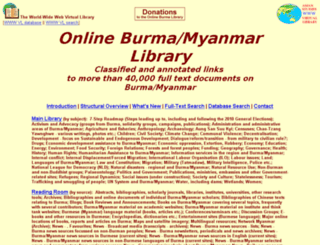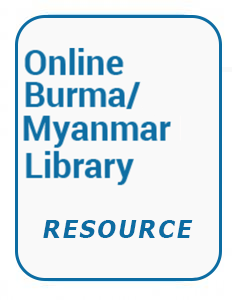Focal point
Location
The Online Burma/Myanmar Library (OBL) is a non-profit online research library mainly in English and Burmese serving academics, activists, diplomats, NGOs, CSOs, CBOs and other Burmese and international actors. It is also, of course, open to the general public. Though we provide lists of Burma/Myanmar news sources, the Library’s main content is not news but in-depth articles, reports, laws, videos and links to other websites, We provide a search engine (database and full text) and an alphabetical list of categories and sub-categories, but the Library is best accessed through browsing the 100 or so categories which lead to sub- and sub-sub categories. These tools should be used in combination.
Members:
Resources
Displaying 821 - 825 of 1151CHR 2003: Myanmar: Thousands of people are displaced and starving
Commission on Human Rights
59th Session
Item 10: Economic, social and cultural rights
"...
It is in the remote parts of Myanmar that the worst abuses of the right to food continue. Within recent weeks, the Asian Legal Resource Centre has spoken with persons travelling in some of these areas. They have told of thousands of people displaced from their lands, some for years, starving in the jungle. One who carried an emaciated child to a Thai town just across the border spoke of the utter shock and disbelief among medical staff at the child?s condition...
After the 1997 Offensives: The Burma Army's Relocation Program in Kamoethway Area
Mass Displacement by the Burmese Army's forced relocation program in Tenasserim division first rose to awareness when multi-national companies started to build the Yadana gas pipeline. What followed was a Burmese Army offensive in 1997 to KNU controlled areas to secure more of the area for their business interests. After the arrival of foreign companies and the Yadana gas pipeline the Kamoethway area became a refuge for those fleeing from the gas pipeline area. Later Kamoethway area itself became another target for Burmese troops trying to gain better access to the gas pipeline.
IDPs in Burma: A short summary
Burma has a population of 50 million people, recent estimates place 2 million of those people as Internally Displaced
Persons (IDP). They live precarious and transient lives in the jungles of Burma’s ethnic border areas and in the more urban
central plains. They are denied the stability of having a home and a livelihood and are forced into a constant state of
movement: never having the opportunity to maintain a home, their farms, access to education and medical facilities and
peace of mind...
IDPs in Burma: A short summary
Burma has a population of 50 million people, recent estimates place 2 million of those people as Internally Displaced
Persons (IDP). They live precarious and transient lives in the jungles of Burma’s ethnic border areas and in the more urban
central plains. They are denied the stability of having a home and a livelihood and are forced into a constant state of
movement: never having the opportunity to maintain a home, their farms, access to education and medical facilities and
peace of mind...
After the 1997 Offensives: The Burma Army's Relocation Program in Kamoethway Area
Mass Displacement by the Burmese Army's forced relocation program in Tenasserim division first rose to awareness when multi-national companies started to build the Yadana gas pipeline. What followed was a Burmese Army offensive in 1997 to KNU controlled areas to secure more of the area for their business interests. After the arrival of foreign companies and the Yadana gas pipeline the Kamoethway area became a refuge for those fleeing from the gas pipeline area. Later Kamoethway area itself became another target for Burmese troops trying to gain better access to the gas pipeline.


